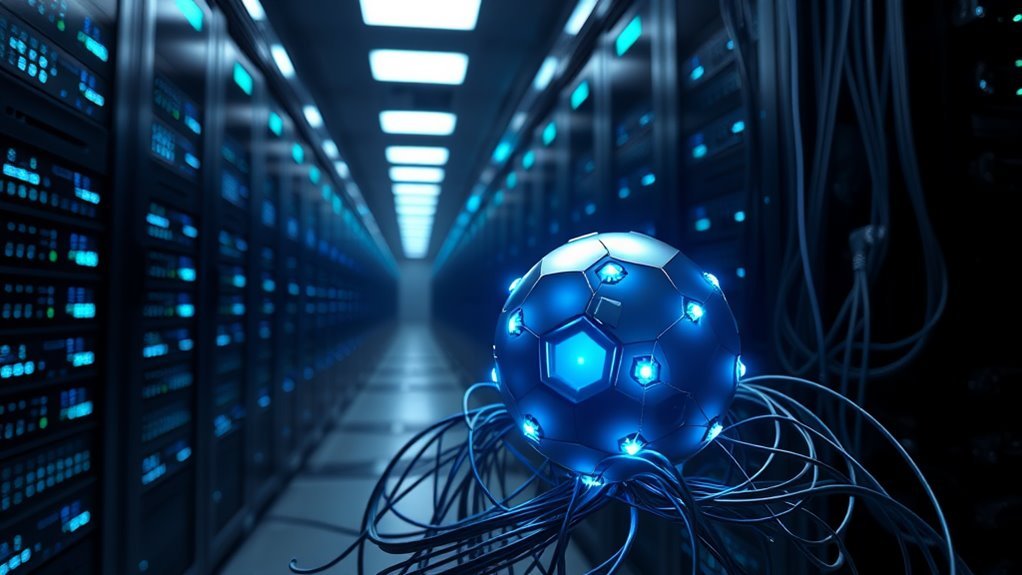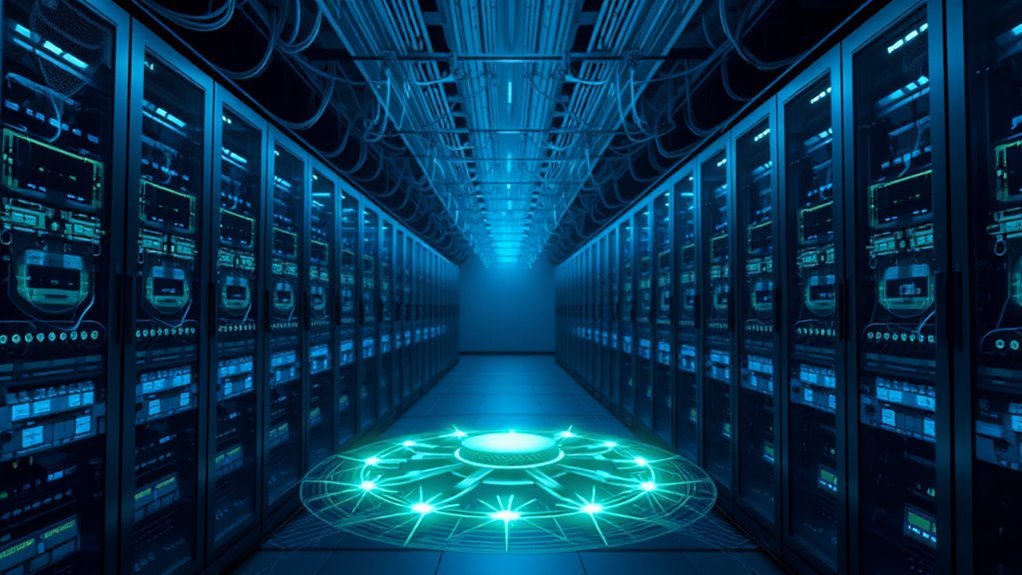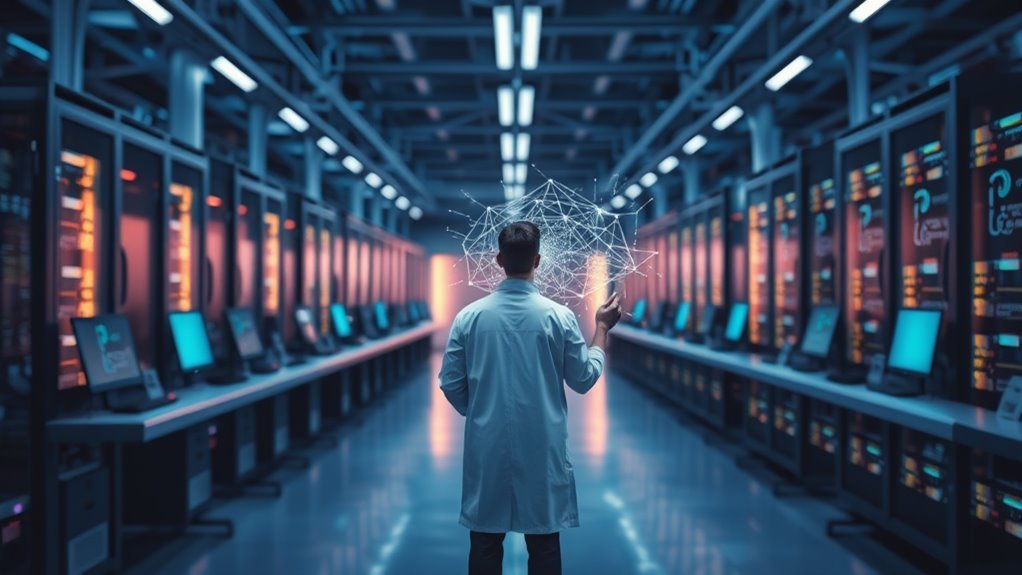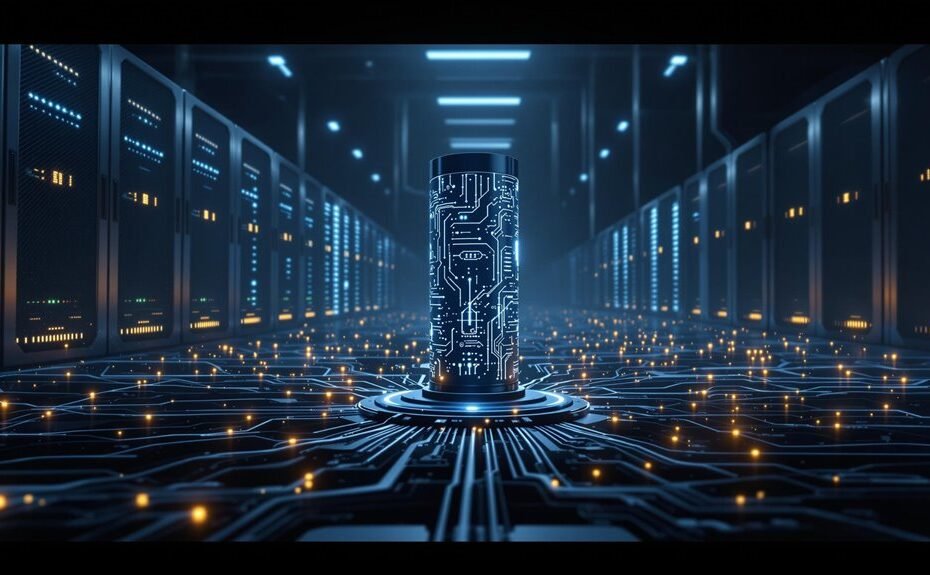When designing blockchain security protocols for AI agent networks, you'll want to prioritize secure communication protocols, such as end-to-end encryption and decentralized identity solutions, to protect data from interception and unauthorized access. Implementing blockchain-based messaging systems and smart contracts can guarantee immutable records and transparent interactions. Decentralized communication and peer-to-peer protocols will allow AI agents to share data and make collective decisions independently. By integrating these measures, you'll be well on your way to creating a robust framework for secure and trustworthy AI agent operations – and there's still more to investigate regarding optimizing your security strategy.
Need-to-Knows
- End-to-end encryption and decentralized identity solutions protect AI agent data from interception and unauthorized access.
- Blockchain-based messaging systems like Whisper and Matrix ensure immutable records for accountability and transparency.
- Smart contracts define communication protocols and govern interactions among AI agents, promoting transparency and trust.
- Decentralized ledger technology and multi-signature wallets provide enhanced security against unauthorized access and cyber threats.
- Reputation systems and adaptive governance models promote accountability among stakeholders and ensure the integrity of AI agent interactions.
Secure Agent Communication Protocols
When it comes to guaranteeing the integrity and confidentiality of data exchanged between AI agents in decentralized environments, secure agent communication protocols are the first line of defense against potential risks of interception and manipulation.
You need protocols that can protect your data from unauthorized access and potential cyber threats. That's where end-to-end encryption comes in – it's a critical component of secure communication protocols.
Implementing decentralized identity solutions, like Self-Sovereign Identity (SSI), can likewise improve secure agent communication by allowing agents to verify identities without relying on a central authority, reducing single points of failure.
To facilitate secure, peer-to-peer communication between AI agents, you can use blockchain-based messaging systems, such as Whisper or Matrix, which maintain an immutable record of interactions for accountability and audit purposes.
Multi-Agent Systems and Communication
As you implement secure agent communication protocols, you'll likely encounter multi-agent systems, where decentralized communication among AI agents allows them to share data and make collective decisions without central oversight.
In these systems, blockchain technology can play an essential role in guaranteeing the integrity and consistency of data exchanged between agents. By utilizing smart contracts, you can define communication protocols and govern interactions between agents, promoting transparency and accountability in their exchanges.
The integration of blockchain technology within multi-agent systems provides an immutable ledger for tracking agent interactions, helping to mitigate disputes and improve trust among participants.
Effective communication within multi-agent systems is critical for tasks like resource allocation and collaborative problem-solving, where agents must coordinate actions based on shared information to achieve common goals.
Blockchain Security for AI Autonomy

Blockchain technology takes AI autonomy to the next level by providing a decentralized and immutable ledger, ensuring data integrity and security for autonomous AI agents.
As you integrate AI with blockchain, you'll experience improved security protocols that protect your agents from unauthorized access and cyber threats.
Here are three key benefits of blockchain security for AI autonomy:
- Decentralized decision-making: Smart contracts facilitate the automatic execution of predefined actions for AI agents, promoting transparency and reducing the risk of manipulation in decision-making processes.
- Autonomous asset management: AI agents can autonomously manage digital assets on blockchain, with decentralized systems minimizing the need for centralized oversight and boosting operational efficiency.
- Real-time threat detection: The integration of AI with blockchain allows for real-time monitoring of transactions, allowing AI agents to detect anomalies and respond to security threats without delay.
AI Agent Network Architecture Design
Designing an AI agent network architecture requires careful consideration of decentralized structures that facilitate secure and transparent interactions between agents and external data sources.
You'll want to utilize blockchain technology to create a robust foundation for your AI agents to operate on. This involves incorporating smart contracts that can autonomously execute predefined actions based on data inputs, allowing AI agents to operate without human intervention. Custom blockchain solutions can be tailored to specific use cases, such as high-frequency trading or asset management, to improve performance.
Interoperability between different blockchain systems is vital for AI agents to share data and communicate effectively. You can achieve this through standards like the Inter-Blockchain Communication Protocol (IBC).
When designing your architecture, don't forget to include security mechanisms like encryption methods, decentralized identity solutions, and fraud-proof mechanisms to safeguard against unauthorized access and data manipulation.
Decentralized AI Agent Security Measures

Building a robust decentralized AI agent network architecture requires implementing stringent security measures to safeguard against potential threats. You must guarantee the integrity of your AI network by leveraging blockchain's immutable ledger to track and verify transactions and model updates.
Here are 3 key measures to improve security:
- Implement smart contracts to automate governance and data sharing, reducing the risk of human error and manipulation.
- Utilize federated learning to train AI models on local data while keeping sensitive information secure and private across the network.
- Integrate decentralized oracles to provide reliable external data to AI agents, minimizing the risk of data manipulation and enhancing the overall trustworthiness of the AI's decision-making process.
Cybersecurity Threats to AI Agents
Cybersecurity threats to AI agents lurk around every corner, waiting to pounce on unsuspecting vulnerabilities in algorithms and smart contracts. As you integrate AI agents into your blockchain network, you expose yourself to a multitude of risks. Unauthorized access to your AI models can lead to devastating consequences, including data breaches and financial losses.
Attackers can manipulate your models or extract sensitive training data, compromising the integrity of your AI operations. You're likewise vulnerable to security concerns in AI training processes, particularly regarding data privacy and compliance with regulations like GDPR.
Common vulnerabilities in Ethereum smart contracts, such as reentrancy attacks and integer overflow, can be exploited by attackers to disrupt your AI agent functionality and steal assets. In addition, the integration of external oracles can introduce additional security risks, including data manipulation and verification challenges, affecting the reliability of your AI agent operations on the blockchain.
It's essential to acknowledge these cybersecurity threats and take proactive measures to safeguard your AI agents and prevent potential disasters.
Blockchain-Based Identity Verification

As you investigate the domain of blockchain security protocols, one vital aspect that demands attention is blockchain-based identity verification. This innovative approach utilizes decentralized ledgers to create secure and tamper-proof identities, guaranteeing that user data is immutable and easily verifiable without reliance on a central authority.
Here are three key benefits of blockchain-based identity verification:
- Improved security: By employing cryptographic techniques, blockchain identity verification boosts security against identity theft and fraud, making it difficult for unauthorized parties to manipulate or access sensitive information.
- Streamlined KYC processes: The implementation of blockchain for identity verification can streamline Know Your Customer (KYC) processes in financial sectors, reducing the time and costs associated with traditional verification methods.
- Portable digital identities: Various projects, such as SelfKey and Civic, utilize blockchain technology to provide users with portable digital identities, enabling them to manage their identity data and share it selectively across platforms.
Smart contracts can automate the identity verification process, allowing for seamless and real-time authentication while maintaining user privacy and control over personal data.
Autonomous AI Agent Governance Models
When integrating blockchain-based identity verification into AI agent networks, you'll need to establish a robust governance model to guarantee the autonomous agents operate securely and efficiently.
Autonomous AI agents can thrive under governance models that utilize Decentralized Autonomous Organizations (DAOs), which allow stakeholders to participate in decision-making processes without a central authority.
These governance mechanisms often incorporate smart contracts to automate compliance with predefined rules and facilitate transparent voting on proposals.
Multi-signature wallets can improve security by requiring multiple approvals for critical transactions or changes in the agent's operation.
Reputation systems can be integrated into governance frameworks to promote accountability, where the trustworthiness of participants influences their voting power and decision-making authority.
It's crucial to adopt adaptive governance models that can evolve based on agent performance and community feedback, promoting the effectiveness and sustainability of autonomous AI systems.
Most-Asked Questions FAQ
How Can Blockchain and AI Be Used Together?
You can harness the power of AI integration with decentralized networks, ensuring data transparency and trustless systems, to create smart contracts that execute autonomously, revolutionizing the way you conduct business and make decisions.
What Is the Security Method of Blockchain?
You're protected by blockchain's robust security methods, which include encryption techniques, consensus algorithms, and decentralized ledgers, in addition to smart contracts and cryptographic keys, ensuring your transactions are secure, transparent, and tamper-proof.
What Is Blockchain for Securing Ai Applications and Open Innovations?
You're leveraging blockchain to secure AI applications, enabling decentralized identity management, smart contract execution, and data integrity assurance, while facilitating secure transactions in trustless environments, ultimately promoting trust and accountability in AI-driven innovations.
How Is AI Used in Network Security?
You're leveraging AI in network security to detect threats in real-time, using predictive analytics to identify anomalies, and automating responses to potential breaches through behavior analysis, ensuring proactive protection against emerging cyber threats.
Conclusion
As you integrate AI agents into complex networks, securing their communication and autonomy becomes essential. By leveraging blockchain security protocols, you can guarantee decentralized, transparent, and tamper-proof interactions. This fusion of blockchain and AI facilitates robust governance models, identity verification, and threat resilience. Embracing these measures will be vital in building trustworthy AI ecosystems that can scale and thrive in an increasingly autonomous future.
